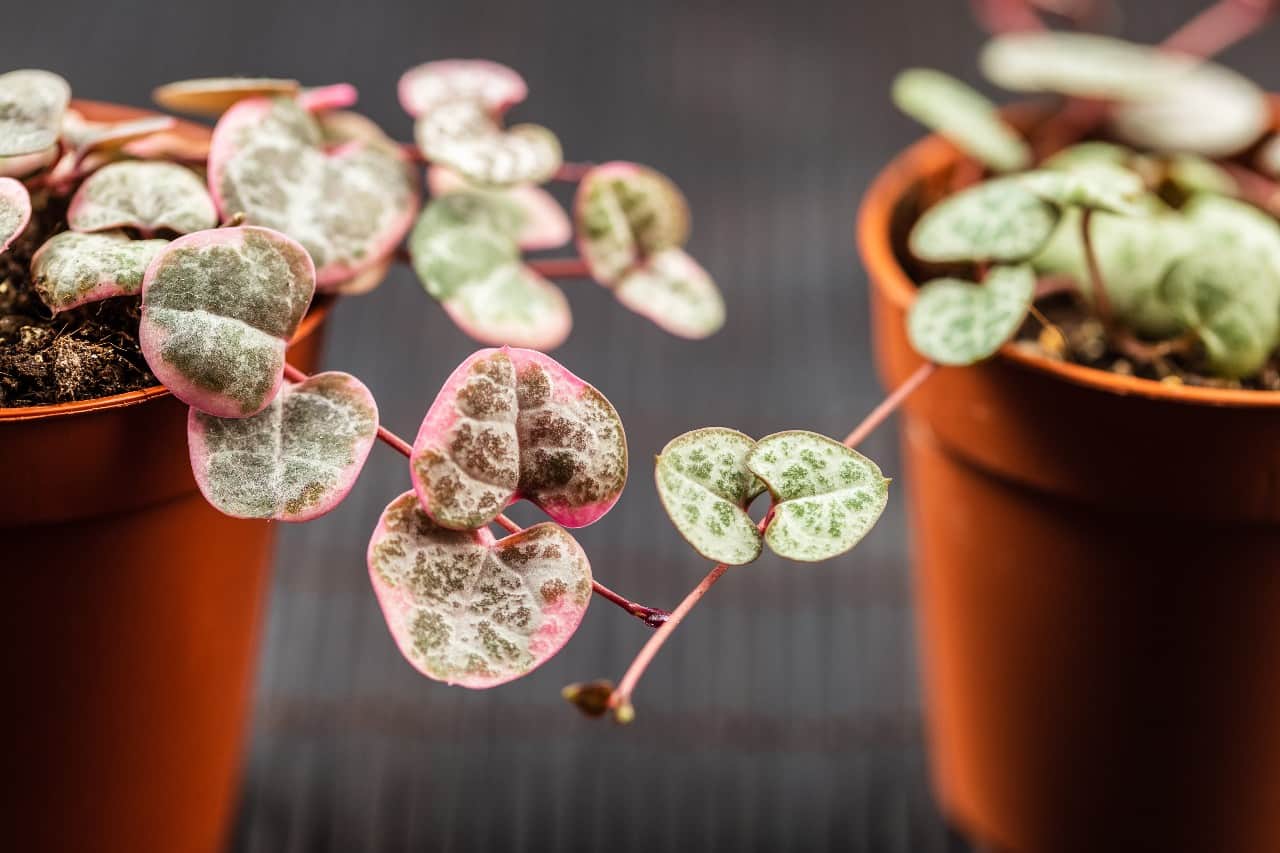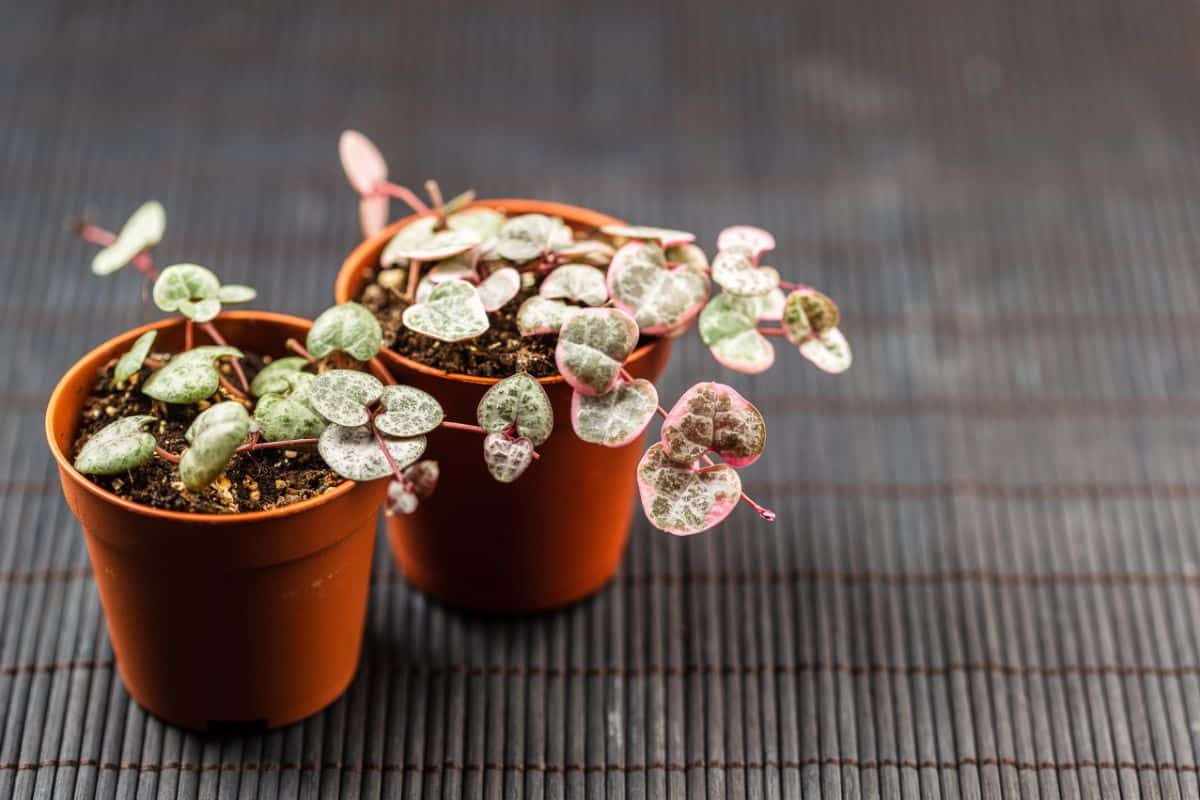
Variegated String of Hearts, or Ceropegia woodii f. variegata, is a favorite among succulent lovers. Not only is it an attractive and unique-looking houseplant, but it’s also incredibly easy to care for and propagate. It’s an ideal choice for succulent lovers of all experience levels.
What makes this plant stand out from the rest is its long, trailing vines covered in fleshy, heart-shaped leaves. The variegated form is even more unique with its white and green leaves and lovely pink blush.
This highly sought-after plant is relatively tolerant of neglect and will do best with a more hands-off approach to its care. If you can get its care right, your Variegated String of Hearts may reward you with an abundance of pink and purple trumpet-shaped blooms.
| Name: | Ceropegia woodii f. variegata |
| Soil: | Succulent/cactus mix |
| Blooming: | Primarily in the summer and fall |
| Light: | 3 to 4 hours of sunlight a day |
| Water: | Dry out between waterings |
| Propagation: | Stem cuttings or seeds. |
Water
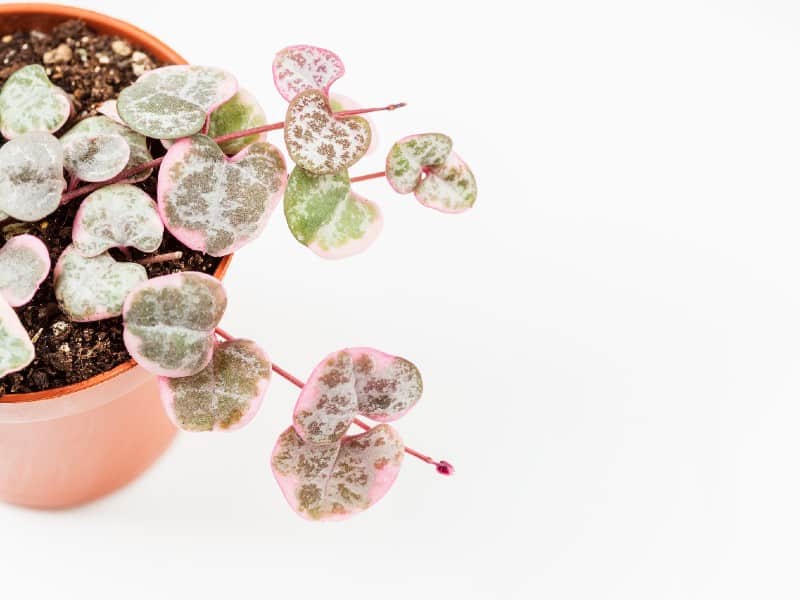
Buy it from:
Variegated String of Hearts requires infrequent water as excess moisture can cause the roots to rot. As with all succulents, standing water should be avoided at all costs. The best strategy is to use the soak and dry method of watering.
This method requires you to thoroughly soak the soil until the excess water runs out of the drainage hole in the bottom of the pot. Once the soil is soaked, it can be allowed to dry out again before watering.
This method only works if you monitor the soil’s moisture levels, so it’s recommended to test the soil using your finger or a soil moisture meter prior to watering.
To check the soil, stick your finger or moisture meter into the soil. You’ll need to get below the surface, as it’s not uncommon for the surface to appear dry while the soil beneath remains moist.
Soil moisture meters typically need a few minutes to give you an accurate read-out, but you should be able to tell right away with your finger. If the soil is moist, it’s best to wait a few days and test it again. If the soil is dry, you can water without worry.
Though this succulent is drought tolerant, String of Hearts tends to enjoy slightly more frequent water than most succulents. Again, you should allow the soil to dry out between watering, but don’t let it stay dry for too long or your String of Hearts may begin to wilt.
In the wild, String of Hearts lives in a relatively dry climate, so it’s generally pretty tolerant of low humidity environments. This isn’t a plant that you need to mist regularly or use a humidifier with.
Variegated String of Hearts will do okay in high humidity environments, though they are less tolerant of humidity during their winter dormancy period.
In humid environments, you’ll need to take care not to accidentally overwater. Since the soil will not dry out as quickly, you will be able to go longer between watering. It will also be especially important to check the soil before watering to make sure it’s dry.
Light
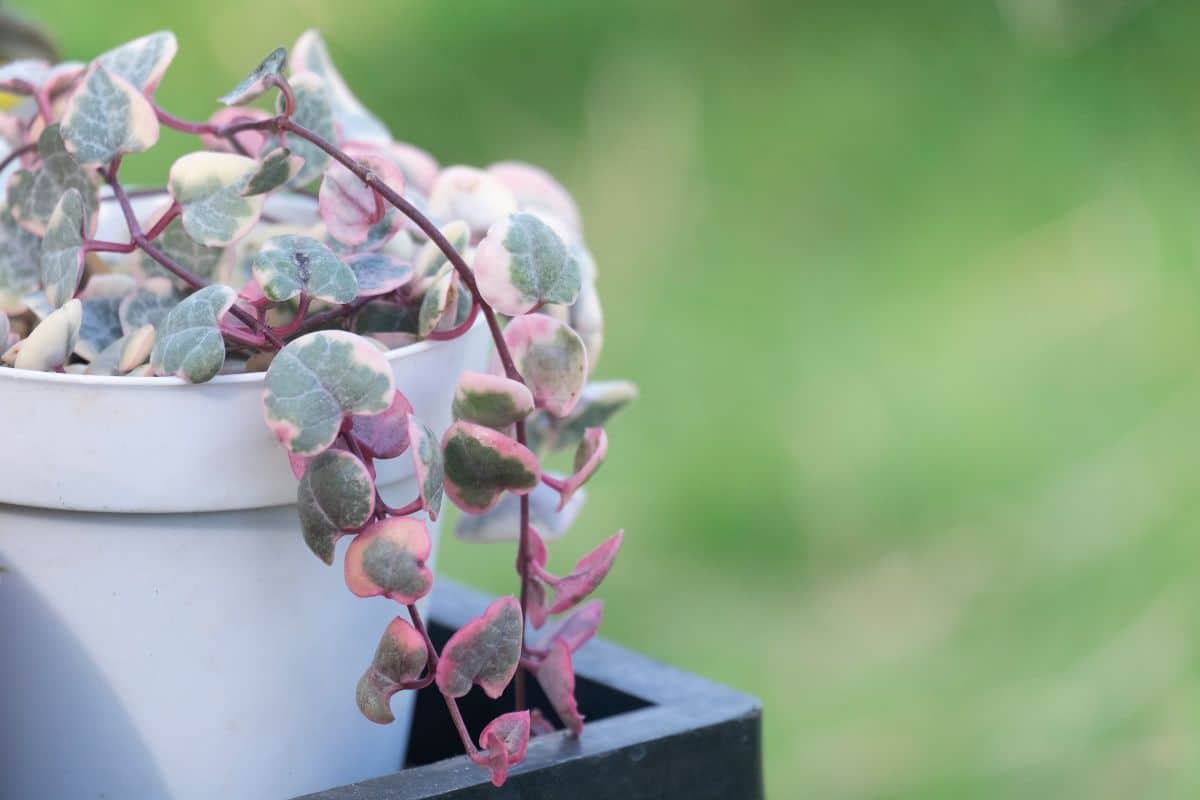
When grown indoors, Variegated String of Hearts will grow best in bright, indirect light. This means that their ideal location will be near a bright window, but not close enough to receive much direct sunlight.
With a south or west-facing window, you’ll likely need to place your succulent a few feet away, but you may be able to keep your String of Hearts directly in a north or east-facing window.
No products found.
Unfortunately, this is not a plant suitable for low-light environments. Without adequate light, your String of Hearts will likely become etiolated and stretched out. Those lovely vines will become leggy and unattractive.
Though etiolation isn’t harmful, most gardeners find the appearance of an etiolated succulent to be quite unattractive. Etiolation is also impossible to repair once it has occurred, so it’s best to prevent it in the first place.
This can be done by placing a full spectrum grow light near your plants. Full-spectrum is preferred as it is the type of light that most closely resembles natural sunlight. Grow lights are typically quite inexpensive and many different sizes and shapes can be found.
If you live in a climate that experiences warm winters, you may also be able to grow your Variegated String of Hearts outdoors. You can also grow it outdoors if you live in a colder climate, but you’ll need to bring it indoors for the duration of the cold season.
When growing String of Hearts outside, be sure to place it in an area where it can receive partial shade or filtered sunlight. Too much direct sunlight will result in sunburn.
Like etiolation, sunburn damage is irreversible. However, unlike etiolation, sunburn can be fatal if you do not address it as soon as possible. Prolonged exposure to direct sunlight can result in the death of your Variegated String of Hearts.
Temperature
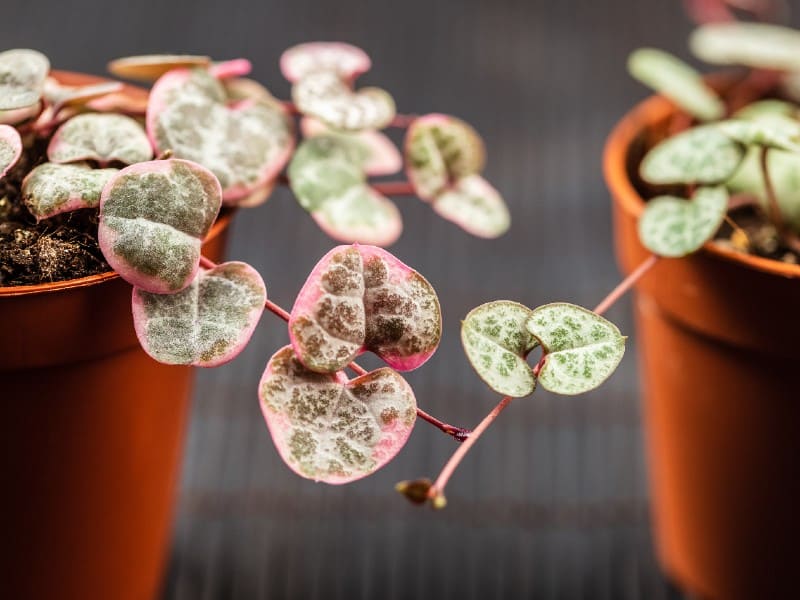
Variegated String of Hearts is not a frost tolerant plant and should not be exposed to temperatures below freezing for prolonged periods of time. They can survive temperatures down to about 20 degrees Fahrenheit, but not for long.
As previously stated, if you live in a climate that experiences frigid winters, it’s best to bring your succulents indoors for the winter.
If you’re growing String of Hearts indoors, the temperature won’t be too much of a concern for you. Most indoor spaces maintain a relatively comfortable temperature year-round. However, it’s best to place your succulent in an area free from sudden changes in temperature or drafts.
It’s also worth noting that Variegated String of Hearts is not particularly tolerant of extreme heat. This is especially true if they receive any amount of direct sunlight, as heat can compound the effects of sunburn.
If you live in a climate that experiences extreme heat, such as the southwestern United States, you may want to consider keeping your String of Hearts indoors. The String of Hearts make great houseplants, so it’s not really necessary to keep them outside if the weather is too extreme.
Soil
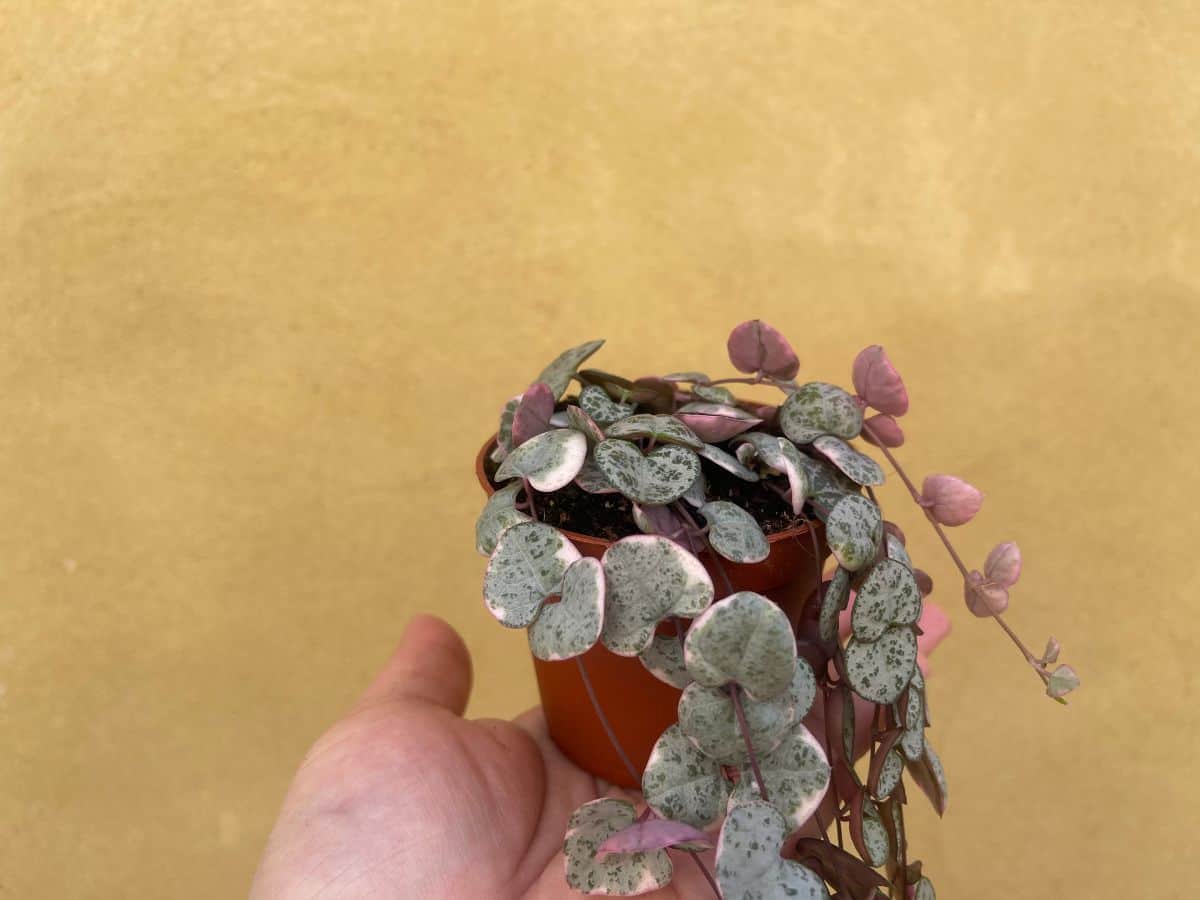
Variegated String of Hearts prefers soil that can provide plenty of drainage and airflow around its roots. If you’re buying a commercial soil mix, look for one labeled for use with succulents and cacti.
These types of soil generally have larger particles of materials such as gravel, coarse sand, perlite, and pumice. They are typically low in water retaining materials such as peat moss, clay, and coconut coir, though small amounts are acceptable.
Most succulent gardeners recommend a soil mix containing between 50% and 70% mineral grit. It’s important for there to be some organic material in the mix as this is where the plant derives its nutrients.
You may use a soil high in mineral grit, but it’s important to be aware that gritty matter doesn’t provide your plant with nutrients, so you’ll need to replenish the soil on occasion by either repotting or fertilizing.
However, caution should be taken when using fertilizer or overly rich soil mixes as this can make your String of Hearts grow too quickly and it will appear leggy.
If you do need to fertilize your String of Hearts, it’s recommended to do so at the beginning of its active growing season. This typically occurs in the spring or summer. You can fertilize your succulent during its winter dormancy, but the plant won’t be able to make use of the nutrients if it’s not actively growing.
Container
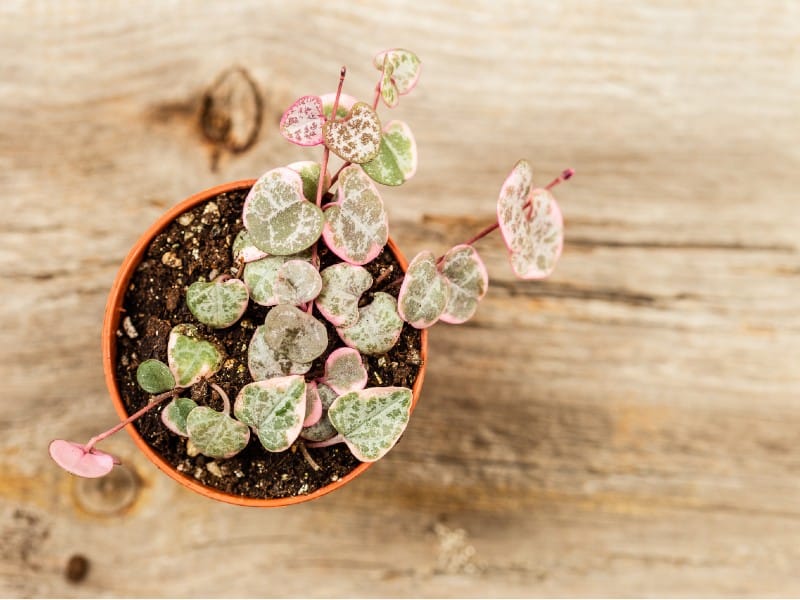
When choosing a pot for your Variegated String of Hearts, look for one that will allow excess water to drain away. Without drainage, your succulent is at risk of rotting, so it’s important to make sure that you can water it thoroughly without the worry of standing water.
If your favorite container does not have a drainage hole, it’s a simple process to drill one or more if you have the right tools and skills. If you aren’t the DIY type, you will need to purchase the correct type of pot.
The material your pot is made of doesn’t matter, but each material has its own unique characteristics to be aware of.
Terra cotta pots tend to absorb water from the soil, so you’ll need to consider this when deciding how frequently to water your String of Hearts. Glazed ceramic or plastic pots do not absorb water, but they do come in a wider range of colors and patterns.
As a trailing succulent, Variegated String of Hearts can be grown in a hanging container to make use of vertical space. It also looks great spilling over the edges of a regular pot or as part of a project such as a fairy garden or living wall.
It’s not recommended to grow this species in a container without drainage. They are sensitive to overwatering and it’s incredibly easy to accidentally overwater when the excess has nowhere to go.
Care Tips
The String of Hearts is not a fast-growing plant, so it’s important to keep this in mind when caring for your succulent. The only time this plant grows relatively quickly is when it’s given too much fertilizer, which tends to result in stringy, straggly growth rather than even, healthy growth.
If you plan on propagating your Variegated String of Hearts, you’ll need to be patient as you wait for your new plants to develop roots and grow.
However, the upside of this slow growth is that you won’t need to repot your succulent often. It can be done as infrequently as every few years, but it’s important to do so occasionally to refresh the nutrients in the soil and provide your plant with more room to expand.
When repotting your Variegated String of Hearts, or any time you need to handle it, use caution as the vines can be somewhat fragile and prone to breakage with rough handling.


